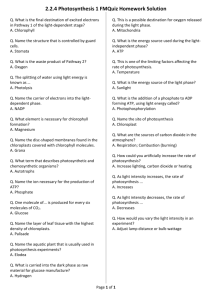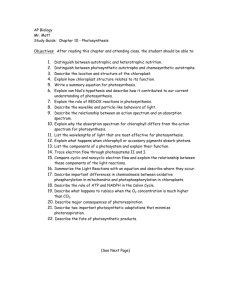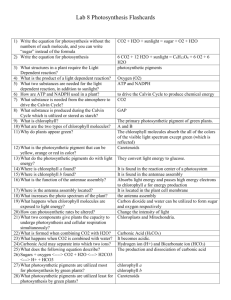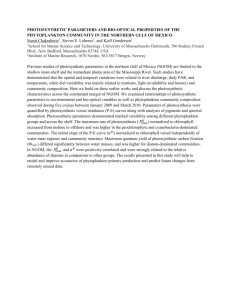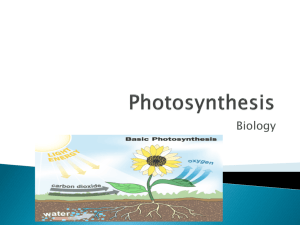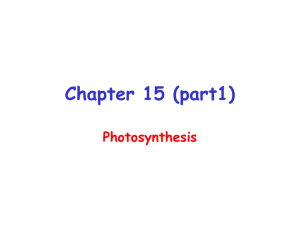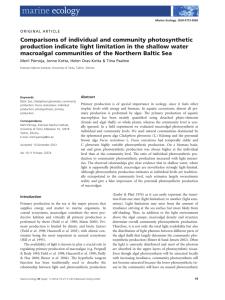Photosynthetic studies
advertisement
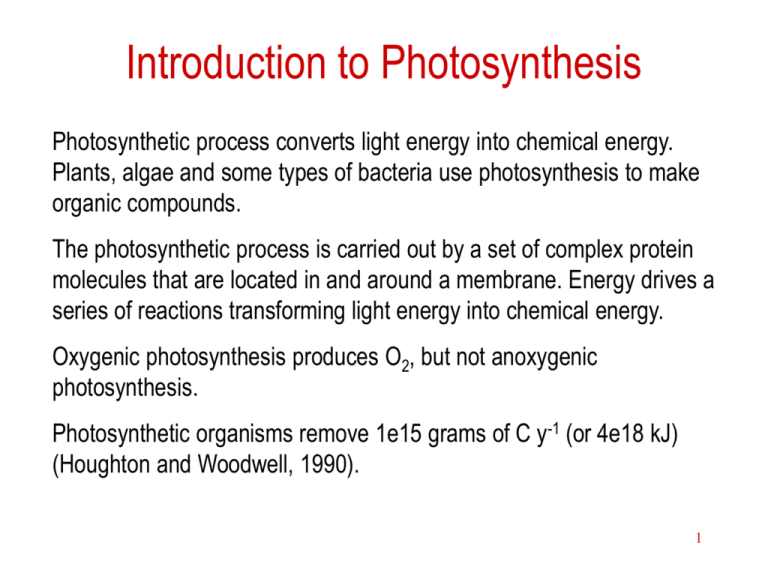
Introduction to Photosynthesis Photosynthetic process converts light energy into chemical energy. Plants, algae and some types of bacteria use photosynthesis to make organic compounds. The photosynthetic process is carried out by a set of complex protein molecules that are located in and around a membrane. Energy drives a series of reactions transforming light energy into chemical energy. Oxygenic photosynthesis produces O2, but not anoxygenic photosynthesis. Photosynthetic organisms remove 1e15 grams of C y-1 (or 4e18 kJ) (Houghton and Woodwell, 1990). 1 Ref: THE PHOTOSYNTHETIC PROCESS In: "Concepts in Photobiology: Photosynthesis and Photomorphogenesis", Edited by GS Singhal, G Renger, SK Sopory, K-D Irrgang and Govindjee, Narosa Publishers/New Delhi; and Kluwer Academic/Dordrecht, pp. 11-51. John Whitmarsh Photosynthesis Research Unit, Agricultural Research Service/USDA Department of Plant Biology and Center of Biophysics and Computational Biology, Uiversity of Illinois at Urbana-Champaign Govindjee Department of Plant Biology and Center of Biophysics and Computational Biology, University of Illinois at Urbana-Champaign Site: life.uiuc.edu/govindjee/paper/gov.html 2 Photosynthetic studies 1640: Jan van Helmont - a Belgian philosopher, chemist and physician – grew a 5 lb willow tree in 200 lbs of soil, and watered regularly with rain water. Within 5 years the tree weighed 169 lbs and the soil 199 lbs. Plants got nutrients from water and somewhere. 1772: Joseph Priestly, a british scientist showed plant shoots produce oxygen. Plants restore oxygen. A few years later, Jan Ingenhousz demonstrated that light is required to produce oxygen. Jean Senebier, a Swiss botanist and naturalist, discovered that CO2 is required for photosynthetic growth and Nicolas- Théodore de Saussure, a Swiss chemist and plant physiologist, showed that water is required. 1800s: F.F. Blackman showed a two-step process for photosynthesis. 3 Photosynthetic studies – cont. 1845 that Julius Robert von Mayer, a German physician and physicist, proposed that photosynthetic organisms convert light energy into chemical energy. Middle of 19th century: A chemical reaction was proposed, CO2 + 2H2O + Light Energy [CH2O] + O2 + H2O Where does O2 comes from, CO2 or H2O? Hill and Scarisbrick (1940) demonstrated oxygen evolution in the absence of CO2 in illuminated chloroplasts and by Ruben et al. (1941) who used 18O enriched water 4 Photosynthetic studies – cont. Carbon reduction can occur in the dark and involves a series of biochemical reactions that were elucidated by Melvin Calvin, Andrew Benson and James Bassham in the late 1940s and 1950s. Using the radioisotope 14C, most of the intermediate steps that result in the production of carbohydrate were identified. Calvin was awarded the Nobel Prize for Chemistry in 1961 for this work. 5 Plant pigments and light absorption 6 CHO in Chlorophyll b Chlorophyll Chlorophyll, a pigment, absorbs sun light. Antenna contains chlorophyll molecules to collect light. Antenna absorb quanta and transfer the reaction center. 7 Energy in light reactions Excite electrons of antenna chlorophyll anchored to proteins Electron transfer chemical reactions in reaction center Proton and electron transfer (redox) reactions (Photosystems I and II) Produce high-energy molecules NADP+ + e NADPH ADP –electrochemical rxn ATP Reduction of CO2 8 Photosystem II PSII is composed of polypeptides P680 and redox components (chlorophyll, pheophytin, plastoquinone, tyrosine, Mn, Fe, cytochrome b559, carotenoid and histidine) light-induced electron transfer drive the oxidation of water and the reduction of plastoquinone PQ Cytochrome b559 must be present, but its involvement in reaction is unknown. 9 Photo-energy in PSII The energy aspect of the various intermediate species in photosynthesis and the products in PSII O2 from H2O 10 The Cytochrome bf Complex The cytochrome bf complex removes the electrons from reduced plastoquinone (PQ or PQH2) and facilitates the release of the protons into the inner aqueous space. The electrons are eventually transferred to the PS I reaction center. Electron transfer from the cytochrome bf complex to photosystem I is mediated by a small Cu-protein, plastocyanin (PC). 11 Photosystem I PS I is composed of a heterodimer of proteins that act as ligands for most of the electron carriers Antenna system (200 mainly chlorophyll a P700 molecules) serve PS I. PS I catalyzes the oxidation of plastocyanin, a small soluble Cuprotein, and the reduction of ferredoxin, a small FeS protein 12 Energy aspects in PS I PS I reduces, Fd, ferredoxin, a small FeS protein 13 The ATP synthesis ATP Synthase complex is composed CF0 and CF1 CF1 CF0 is a channel for H+ CF1 has several protein subunits for the reaction ADP + Pi + H+ ATP+ H2O CF0 ATP is the energy molecule of life. 14 Photosynthesis The protons released into the inner aqueous solution results in a difference in pH and electrochemical potential across the membrane. 15 h Light and Dark Reactions H2O CO2 NADPH ATP O2 Sugar 16 The Calvin Cycle for Dark Reactions 17 Final exam date Chem218 Dec. 15, 19-22 pm, MC 4040 18




